Statements and messages of the Prime Minister of RA
"Durable peace in the South Caucasus is not only possible but also realistic” - Prime Minister’s speech at the "Yerevan Dialogue" international conference
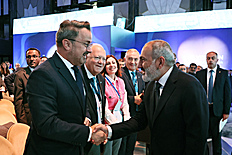 1670x1113px - 829 Kb
1670x1113px - 829 Kb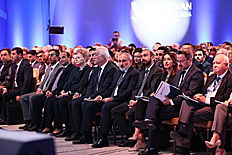 1670x1113px - 846 Kb
1670x1113px - 846 Kb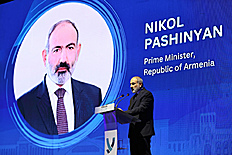 1670x1113px - 1 Mb
1670x1113px - 1 Mb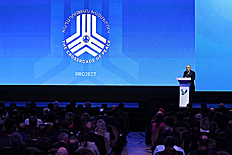 1670x1113px - 1 Mb
1670x1113px - 1 Mb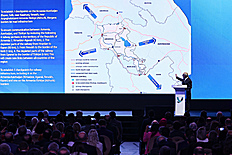 1670x1113px - 1 Mb
1670x1113px - 1 Mb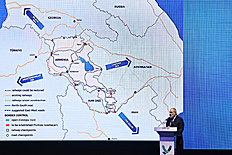 1670x1113px - 2 Mb
1670x1113px - 2 Mb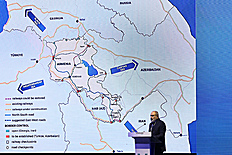 1670x1113px - 2 Mb
1670x1113px - 2 Mb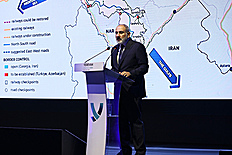 1113x1670px - 1 Mb
1113x1670px - 1 Mb 1670x1113px - 807 Kb
1670x1113px - 807 Kb 1670x1113px - 1 Mb
1670x1113px - 1 Mb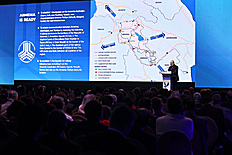 1670x1113px - 862 Kb
1670x1113px - 862 Kb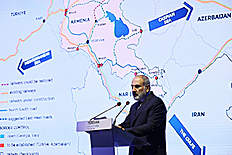 1670x1113px - 1 Mb
1670x1113px - 1 Mb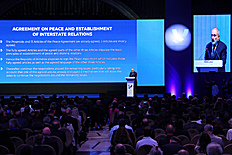 1670x1113px - 847 Kb
1670x1113px - 847 Kb 1670x1113px - 1 Mb
1670x1113px - 1 Mb 1670x1113px - 592 Kb
1670x1113px - 592 Kb 1670x1113px - 1 Mb
1670x1113px - 1 Mb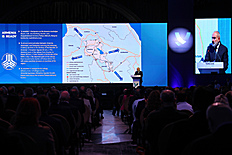 1670x1113px - 724 Kb
1670x1113px - 724 Kb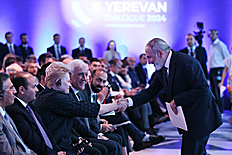 1670x1113px - 783 Kb
1670x1113px - 783 Kb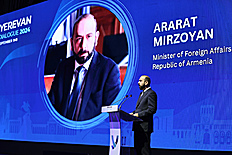 1670x1113px - 986 Kb
1670x1113px - 986 Kb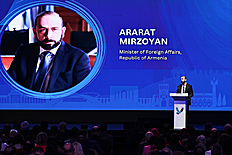 1670x1113px - 843 Kb
1670x1113px - 843 Kb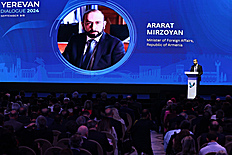 1670x1113px - 910 Kb
1670x1113px - 910 Kb
more 18 photos
Prime Minister Nikol Pashinyan attended the opening ceremony of the "Yerevan Dialogue" international conference. The conference was organized by the Ministry of Foreign Affairs of the Republic of Armenia in collaboration with the Observer Research Foundation of India and features representatives from official, expert, academic, business circles, international organizations, celebrities, opinion leaders, and analysts from over 80 countries.
Nikol Pashinyan delivered a speech in which he stated:
"Honorable President of the Republic of Armenia,
Dear guests,
I welcome you to the launch and founding of “Yerevan Dialogue” conference.
Obviously, “Yerevan Dialogue” is an important platform for discussing questions of international and regional agenda and sharing thoughts, proposing ideas. I wish to immediately address the question that is perhaps of the greatest interest to this audience. Is durable and lasting peace in the South Caucasus possible? Is it realistic?
This is, of course, a question to be answered by not only the Republic of Armenia. I will try to answer our share of the question, and I will answer it from the standpoint of the Republic of Armenia. Thus, durable peace in the South Caucasus is not only possible, but also realistic. Let me now present a few points to substantiate our position and justify why I think so. First of course, I need to turn to negotiations on a peace agreement between Armenia and Azerbaijan. You have recently heard much that 80% of the peace agreement has been agreed upon, there have been statements about it at different fora. Let me tell you what that means in practice.
In the current draft of the peace agreement and with the current results, the draft’s preamble and thirteen articles have been fully agreed upon, and three further articles, each of which consists of about two sentences, are partly agreed, and to be more specific, one of the sentence of this two articles is agreed, the other sentence is not agreed.
The Republic of Armenia, taking into account, that the agreed articles of the peace agreement between Armenia and Azerbaijan actually contain internationally accepted core provisions for establishing relations, we propose to take what is currently agreed, to sign it, to have a fundamental document, and then continue the discussions of the other questions, especially because one of the agreed articles of the peace agreement stipulates the mechanism that enables both sides, the Republic of Armenia and the Republic of Azerbaijan, to continue the negotiations. Let alone that the currently agreed part of the peace agreement obviously contains a provision on establishing diplomatic relations between Armenia and Azerbaijan. Therefore, we have opted for these solutions, we propose this publicly. I want to reiterate my willingness, our willingness to sign in the nearest possible time frame the agreed text of the peace agreement.
The next important topic is of course the process of delimitation between the Republic of Armenia and the Republic of Azerbaijan. We have had considerable progress here, as manifested in the facts that the relevant commissions of Armenia and Azerbaijan recently signed the regulation on the joint activities of the delimitation commissions. The regulation states or contains what the parties had declared on April 19 of this year, as a result of the 8th meeting of the commissions, in the statement that was published after the meeting. The Alma-Ata Declaration as the basic principle for the delimitation process is recorded. And it states that in the delimitation process the sides will be governed by the Alma-Ata Declaration.
For those who wish to be informed in greater detail, I want to highlight that the Alma-Ata Declaration was signed by a number of Soviet Republic, including Armenia and Azerbaijan, and this declaration contains two important provisions for the topic at stake. The first provision is the following: The Soviet Union shall cease to exist. And the second is that the countries that signed the Alma-Ata Declaration recognize and respect each other’s territorial integrity and the inviolability of the existing borders. This is a very important foundation. If we were to interpret this, the relevant provision of the Alma-Ata Declaration would mean that the Republic of Armenia and the Republic of Azerbaijan mutually recognize each other within the territories of relevant Soviet republics.
As currently noted, according to the agreement, this regulation is now going through domestic procedures for approval in Armenia and Azerbaijan, and I hope and trust that at least in Armenia we will do everything to finalize this regulation. Our government has now adopted that draft and sent it to the Constitutional Court for checking its constitutionality.
The next important topic for evaluating the situation in our region and establishing durable peace is of course the opening of regional communications. I hope you are aware of the “Crossroads of Peace” initiative adopted by the Government of Armenia. This project is not only about the communications between Armenia and Azerbaijan: railway, roads, potential cables, gas pipelines, electricity lines, other communication channels, but there will be a similar development between Armenia and Turkey.
Of course, the “Crossroads of Peace” is important for us for another reason. If it is implemented, we will be able to connect with the Islamic Republic of Iran by railway. Understandably and obviously, the relations with Iran is very important for us. We will be able to connect by railway also with Turkey, Europe, Russia. Of course, Azerbaijan will be able to have a rail connection with Turkey, the Islamic Republic of Iran and of course, what is important here, is the railway and road connection between Nakhichevan and the main part of Azerbaijan, through the territory of Armenia. As it’s clear from the project, we stand ready to provide that communication, but we must also note that currently the Autonomous Republic of Nakhichevan is connected with the outside world, it does have transport connection via the territory of Iran, via the territory of Turkey. We stand ready at any time to engage in the implementation of this project, including ensuring transport communication between Nakhichevan and the main part of Azerbaijan.
Moreover, it’s two years there is a draft government decree, it’s in or around the government agenda that we are ready to carry out this process. What is hindering this process? Apparently not all of our partners are inclined to make use of the possibility that we offer. You must have heard that it’s much discussed the extent to which the “Crossroads of Peace” project is in line with the logic of the trilateral statement of November 9, 2020. With a recently reactivated discussion, there is an attempt to present that the November 9 trilateral statement implies that the security of these communications in the territory of Armenia shall be secured by third parties or a third country.
I must say straight away that that that perception has nothing to do with the reality. To make it more substantiated, let me now quote paragraph 9 of the November 9, 2020 trilateral statement: “The Republic of Armenia shall guarantee transport communication security between Nakhichevan and eastern part of Azerbaijan, and the unhindered movement of citizens and cargo in both directions”.
As you see, the November 9 trilateral statement provides that the Republic of Armenia shall have the role of ensuring the security of communications in the territory of Armenia. This is an open and public text. And it could not be otherwise, because it would be illogical that another country should provide security in the territory of a sovereign country.
More broadly, I want to tell that by referring to the November 9 trilateral statement, some international partners are trying to present something that does not exist in the November 9 statement. For example, the November 9 trilateral statement does not say that over any territory of Armenia, there will be the control of another country. The November 9, 2020 statement does not contain such a provision at all. And this is a public document, I repeat. I invite everyone to search and find, and once you find, we don’t mind if you inform us if you find something other than this in the text. But such a text does not exist, I tell you as the person who signed it. What is also lacking in that statement is the provision implying that the jurisdiction of the Republic of Armenia over its sovereign territory would in any way be limited, in terms of customs, borders, phytosanitary and other controls. There is simply no such provision, and it could not exist.
But very importantly, what I just quoted as text that does not exist in the November 9, 2020 statement , many people try to present as provisions of the November 9 trilateral statement. This is a new diplomatic technique, which I frankly do not understand. To refer to a document and to present a provision that simply does not exist in the document. Such modus operandi is not understandable to us, and to speak directly is unacceptable to us. Instead, if want to see what the November 9 trilateral statement does contain, there is an attempt to present paragraph 9 or the November 9 statement as if it is a document about connecting Nakhichevan with the main part of Azerbaijan, but the paragraph says that all economic and transport connections in the region shall be unblocked, the linkage between Nakhichevan and the main part of Azerbaijan is sub-paragraph of paragraph 9. Whereas Paragraph 9 is mainly about unblocking all economic and transport connections.
Paragraph 7 of the statement provides that internally displaced persons and refugees return to the Nagorno Karabakh territory and the adjacent regions under the supervision of the UN High Commissioner for Refugees. As you can see, after November 9, 2020, when the President of the Russian Federation and the President of Azerbaijan and myself signed this document, the Armenian refugees that left Nagorno Karabakh and the adjacent territories not only did not return to Nagorno Karabakh and the adjacent regions, but as a consequence of other events that unfolded a year ago, Nagorno Karabakh was fully emptied of Armenians, as a result of ethnic cleansing.
Paragraph 8 of the November 9, 2020 trilateral statement provides that exchange of POWs, hostages and other detained persons, as well as the bodies of the deceased shall be carried out. To date, there are POWs, hostages and other detained persons in Azerbaijan, they have not been returned to date, and this is also a provision that can be found in the November 9 trilateral statement. As you can see, it has not been implemented.
I need to tell you that unfortunately non of the partners has any basis for accusing Armenia of failing to implement any of the provisions the November 9 statement. Unfortunately, I must say that no partner has any basis for accusing Armenia of failing to implement any provision of the November 9 statement. However, as you can see, the Republic of Armenia and, in general, any independent and objective observer has grounds to say that our other partners, signatories of the statement have not at least fully fulfilled their obligations.
Therefore, dear ladies and gentlemen, this is the logic behind the "Crossroad of Peace," the delimitation process, and the agreed text of the peace treaty that we propose for ensuring durable and sustainable peace in our region. But a question may arise, what are the arguments counter to these arguments?
I have addressed the counterarguments regarding to the "Crossroad of Peace." Now I want to address the counterarguments related to the peace process. Recently, you have heard many statements claiming that the Constitution of the Republic of Armenia allegedly contains territorial claims against Azerbaijan. What substantiates these claims? Those who try to substantiate it say that, for example, the preamble of the Constitution contains partial reference to the Declaration of Independence of the Republic of Armenia adopted on August 23, 1990, that is, still when the Soviet Union existed. The declaration refers to the joint decision of the Armenian SSR Supreme Council and Nagorno-Karabakh National Council on the reunification of the Armenian Socialist Republic and Nagorno Karabakh dated December 1, 1989. This seems a grounded argument, but let me go to Paragraph 5 of the Declaration, sorry for delving into this level of details, but it is very important that the topic being discussed or attempted to be widely discussed is understood with its broad details. The Declaration of Independence of Armenia states that the Republic of Armenia, in order to ensure its security and inviolability of borders, shall stablish armed forces, internal troops, and state, social and public security bodies under the Supreme Council. This was adopted on August 23, 1990, stating that police, troops, and security agencies arshall be subordinate to the Parliament. However, in 1995, when the Constitution of the Republic of Armenia was adopted, and even before that, all of Armenia's security agencies were subordinate to the President of the Republic, and after the 2015 constitutional amendments, they have been subordinate to the Government. What does this mean? It means that the provisions of the Declaration of Independence are reflected in the Constitution of the Republic of Armenia in so far they are reflected literally and verbatim, which is a very important aspect of our legal architecture, that we need to understand laws and texts literally and verbatim.
The Constitution of the Republic of Armenia says nothing about the claims that are being attempted to be attributed to the Constitution of Armenia. This is similar to the situation with the November 9 trilateral statement, where an attempt is made to attribute something to the Constitution of Armenia that is simply not written in it and does not exist in the text of the Constitution. On the contrary, Article 5, Point 3 of the Constitution of Armenia stipulates that “In case of contradiction between the norms of international treaties ratified by the Republic of Armenia and domestic laws, the provisions of international treaties shall apply.” This is another key principle. The peace treaty between Armenia and Azerbaijan as to be ratified by the Armenian Parliament, would mean that this agreement does not contradict the Constitution of Armenia. The moment it is ratified, it becomes superior over all other possible laws. This is a factor that must also be considered. But I want to note that the reality is somewhat different.
The reality is that the Constitution of Azerbaijan contains territorial demands against the Republic of Armenia. How is this substantiated? The constitutional act adopted by Azerbaijan in 1991 is the foundation of the Constitution of Azerbaijan and this is stated in the Constitution of Azerbaijan. The constitutional act, in turn, refers to and is based on the declaration of the establishment of the first Azerbaijani Republic in 1918. That is, the Constitution is based on the 1991 Independence Act, and the Independence Act of 1991 is in turn based on the 1918 Declaration of Independence. The 1918 Declaration of Independence proclaims that the territories of Azerbaijan shall include Eastern and Southern Transcaucasia. Moreover, in 1919, maps were submitted to the Paris Peace Conference and the League of Nations for the registration of the Democratic Republic of Azerbaijan contained the entire Syunik and Vayots Dzor regions of the Republic of Armenia, as well as parts of Ararat, Armavir, Gegharkunik, Tavush, Lori, and Shirak regions.
All of this makes obvious that the Constitution of Azerbaijan does contain territorial claims against the Republic of Armenia. But it is also important to note that we do not make this a topic of negotiation; we do not raise this issue because we believe that in the text of the peace treaty we agreed upon there is a provision that we see as follows: None of the parties can invoke the provisions of its internal legislation as justification for its failure to carry out the international agreements. That is, we see on the one hand that the Constitution of Azerbaijan does contain territorial claims against the Republic of Armenia, but we do not raise this issue not to drive the peace process to deadlock, also because we believe that the text of the peace treaty fully addresses this problem and the international treaty provides that the parties may not invoke their domestic legislation as justification for failure to comply with their obligations under the international agreement.
Dear colleagues, this brings me back to where I began and I wish to reiterate that this is truly a crucial moment for our region. We should take what is agreed upon. Let me repeat, what is agreed upon, as admitted by representatives of Azerbaijan as well, this is nearly 80 percent of the potential substance of the peace agreement. This means that Armenia and Azerbaijan together have a substantial package, if I may put it this way, for the peace treaty. We propose putting the 13+3 agreed provisions on the table, signing them now, and move on to discuss the remaining issues. I also want to especially hope that this esteemed audience will agree that there has never been an agreement anywhere that addresses and solves all problems. No such agreement exists. Whatever agreement we sign, whether 20, 30, 40, 50, or even 100 articles, there will still be 200, 300 potential articles that will not be addressed in that agreement. There are no countries that regulate relationships through one agreement only. But it is very important to set the foundation or not to reject the foundation that has already been laid after several years of negotiations. I hope that in the near future we will have a chance to sign the already agreed part of the peace agreement, and to move on to further negotiations to resolve the other potential issues.
Honorable President of the Republic of Armenia, Dear colleagues,
Thank you for your attention, and I wish success to the "Yerevan Dialogue" conference, not only for 2024 but also for 2025, 2026, and the years to come. Thank you".